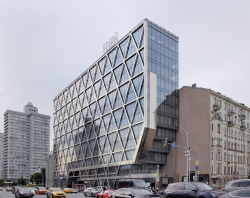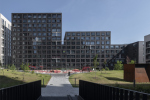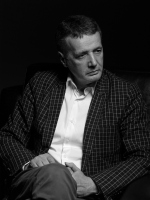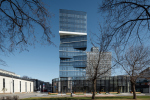13.10.2025
Vladimir Plotkin:
Back to ArchitectТs Profile
18.09.2025
Julia Tarabarina. The Angle of String Tension
The House of Music, designed by Vladimir Plotkin and the architects of TPO Reserve, resembles a harp, and when seen from above, even a bass clef. But if only it were that simple! The architecture of the complex fuses two distinct expressive languages: the lattice-like, transparent, permeable vocabulary of УclassicalФ modernism and the sculptural, ribbon-like volumes so beloved by todayТs neo-modernism. How it all works Ц where the catharsis lies, which compositional axes underpin the design, where the project resembles Zaryadye Concert Hall and where it does not Ц read in the article below.31.10.2024
Julia Tarabarina. Layers and Levels of Flight
This project goes way back Ц Reserve Union won this architectural competition at the end of 2011, and the building was completed in 2018, so itТs practically УarchivalФ. However, despite being relatively unknown, the building can hardly be considered УdatedФ and remains a prime example of architectural expression, particularly in the headquarters genre. And itТs especially fitting for an aviation company office. In some ways, it resembles the Aeroflot headquarters at Sheremetyevo but with its own unique identity, following the signature style of Vladimir Plotkin. In this article, we take an in-depth look at the United Aircraft Corporation (UAC) headquarters in the Moscow agglomeration town of Zhukovsky, supplemented by recent photographs from Alexey Naroditsky Ц a shoot that became only recently possible due to the fact that improvements were finally made in the surrounding area.15.08.2024
Julia Tarabarina. Projection of the Quarter
No one doubted that the building that Vladimir Plotkin designed as part of the УGarden QuartersФ would be the most modernist of all. And it turned out just that way: while adhering to the common design code, the building successfully combines brick and white stone, rhythmically responding to the neighboring building designed by Ostozhenka, yet tactfully and persistently making a few statements of its own. This includes the projection of the ideal urban development composition У14Ц9Ц6Ф, which can be found right next door, mathematical calculations, including those for various types of terraces (and perhaps the only reminder of the Soviet past of the Kauchuk rubber factory!), and the white Уcross-stitchФ pattern of the façade grid.16.04.2024
Julia Tarabarina. Part of the Ideal
In 2025, another World Expo will take place in Osaka, Japan, in which Russia will not participate. However, a competition for the Russian pavilion was indeed held, with six projects participating. The results were never announced as RussiaТs participation was canceled; the competition has no winners. Nevertheless, Expo pavilion projects are typically designed for a bold and interesting architectural statement, so weТve gathered all the six projects and will be publishing articles about them in random order. The first one is the project by Vladimir Plotkin and Reserve Union, which is distinguished by the clarity of its stereometric shape, the boldness of its structure, and the multiplicity of possible interpretations.12.09.2023
Julia Tarabarina. The Chinese Symphony
The construction of the Chinese center УHuaming ParkФ has been a long story that came to fruition relatively recently. The building is adjacent to a traditional Chinese garden, but it is very modern, laconic and technological, and the simple-in-form, yet spectacular, white lamellae promise to someday be incorporated as a media facade. This complex is also truly multifunctional: it contains different types of living spaces, offices, a large fitness center, conference halls and restaurants Ц all wrapped in one volume. You can comfortably hold international forums in it, having everything you may possibly need at your fingertips, and going outside only to take a walk. In this article, we are examining this complex in detail.15.06.2023
Julia Tarabarina. From Darkness to Light
Responding to a lengthy list of limitations and a lengthy Ц by the standards of a small building Ц list of functions, Vladimir Plotkin turned the project of the Novodevichy Monastery into a light, yet dynamic statement of modern interpretation of historical context, or, perhaps, even interpretation of light and darkness.07.06.2022
Julia Tarabarina. Consistency of the Method
Marking its 35th anniversary, Reserve Union (officially named OOO TPO Reserve in Russia) used the venue of the Arch Moscow convention to showcase its hitherto unannounced projects. We asked Vladimir Plotkin a few questions, and we are showing a few pictures Ц without any captions yet.11.05.2022
Julia Tarabarina. Vladimir Plotkin: УOur profession is complex, vulnerable, and sometimes defenseless against criticismФ
As part of the editorial project devoted to the high-rise and high-density construction that Moscow is seeing in recent years, we spoke to the leading architect of CU Reserve Vladimir Plotkin, the author of many grand-scale Ц and high-profile Ц buildings of this city. We spoke about an architectТs role and his tasks in the mega-construction process, about the drive of the megalopolis, about the strong sides of mixed and multifunctional construction, and about the methods of organizing big forms.12.03.2021









